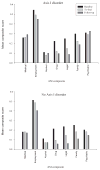Psychopathology in methamphetamine-dependent adults 3 years after treatment
- PMID: 20078677
- PMCID: PMC3772133
- DOI: 10.1111/j.1465-3362.2009.00081.x
Psychopathology in methamphetamine-dependent adults 3 years after treatment
Abstract
Introduction and aims: Although psychiatric symptoms are frequently observed in methamphetamine (MA) users, little is known about the prevalence of psychiatric disorders in MA-dependent individuals. This is the first study to examine the association of psychiatric disorders with substance use and psychosocial functioning in a large sample of MA users 3 years after treatment. We predicted that psychiatric diagnoses and severity would be associated with substance use and poorer overall functioning over the 3 year post-treatment course.
Design and methods: Participants (N = 526) received psychosocial treatment for MA dependence as part of the Methamphetamine Treatment Project and were reassessed for psychosocial functioning and substance use at a mean of 3 years after treatment initiation. DSM-IV psychiatric diagnoses were assessed at follow-up using the Mini-International Neuropsychiatric Interview. Psychosocial functioning was assessed using the Addiction Severity Index.
Results: Overall, 48.1% of the sample met criteria for a current or past psychiatric disorder other than a substance use disorder. Consistent with prior reports from clinical samples of cocaine users, this rate was largely accounted for by mood disorders, anxiety disorders and antisocial personality. Those with an Axis I psychiatric disorder evidenced increased MA use and greater functional impairment over time relative to those without a psychiatric disorder.
Discussion and conclusions: This initial investigation of psychiatric diagnoses in MA users after treatment indicates elevated rates of Axis I and II disorders in this population and underscores the need for integrated psychiatric assessment and intervention in drug abuse treatment settings.
Figures
References
-
- Rounsaville BJ, Dolinsky ZS, Babor TF, Meyer RE. Psychopathology as a predictor of treatment outcome in alcoholics. Arch Gen Psychiatry. 1987;44:505–13. - PubMed
-
- Rounsaville BJ, Kosten TR, Weissman MM, Kleber HD. Prognostic significance of psychopathology in treated opiate addicts. A 2. 5-year follow-up study. Arch Gen Psychiatry. 1986;43:739–45. - PubMed
-
- Verheul R, van den Brink W, Hartgers C. Personality disorders predict relapse in alcoholic patients. Addict Behav. 1998;23:869–82. - PubMed
-
- Regier DA, Farmer ME, Rae DS, et al. Comorbidity of mental disorders with alcohol and other drug abuse. Results from the Epidemiologic Catchment Area (ECA) Study. JAMA. 1990;264:2511–8. - PubMed
-
- Kessler RC, Nelson CB, McGonagle KA, Edlund MJ, Frank RG, Leaf PJ. The epidemiology of co-occurring addictive and mental disorders: implications for prevention and service utilization. Am J Orthopsychiatry. 1996;66:17–31. - PubMed
Publication types
MeSH terms
Substances
Grants and funding
LinkOut - more resources
Full Text Sources
Medical
Miscellaneous


